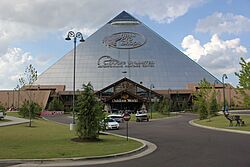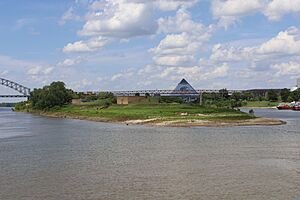Memphis Pyramid facts for kids
Quick facts for kids Memphis Pyramid |
|
|---|---|

The Pyramid in 2016
|
|
| Former names | Great American Pyramid Pyramid Arena |
| Alternative names | The Pyramid Bass Pro Shops Pyramid Tomb of Doom |
| General information | |
| Location | Memphis, Tennessee |
| Address | 1 Bass Pro Drive |
| Current tenants | Bass Pro Shops |
| Groundbreaking | September 15, 1989 |
| Opened | November 9, 1991 |
| Renovated | November 2011–April 2015 |
| Cost | US$65 million ($117 million in 2021 dollars) |
| Owner | City of Memphis |
| Height | 321 feet (98 m) |
| Design and construction | |
| Architect | Rosser Fabrap International O.T. Marshall Architects (Bass Pro Shops improvements) |
The Memphis Pyramid is a huge building shaped like a pyramid. You can find it in downtown Memphis, Tennessee, right by the Mississippi River. It was built in 1991 and used to be a big sports arena.
This pyramid is special because it reminds people of the ancient pyramids in Egypt. It stands 321 feet (98 m) tall, which is about 32 stories high! Its base sides are 591 feet (180 m) long. Some people even say it's one of the ten tallest pyramids in the world.
After 2007, the Memphis Pyramid wasn't used much for sports or concerts. But in 2015, it got a new life! It reopened as a giant Bass Pro Shops store. Now, it's a place where you can shop, stay in a hotel, eat at restaurants, go bowling, and even try archery. There's also an observation deck at the very top where you can see amazing views. Inside, Ducks Unlimited has a museum about waterfowl hunting and protecting wetlands.
Contents
Building the Giant Pyramid
The idea for the Great American Pyramid started way back in 1954. A Memphis artist named Mark C. Hartz first thought of it. His original plan was to build three pyramids on the bluffs overlooking the Mississippi River. The biggest one would have been two-thirds the size of the famous Great Pyramid of Giza in Egypt.
This big idea didn't happen for about 30 years. Then, Mark C. Hartz's son, Jon Brent Hartz, brought the idea back to life. His father, who was good at drawing buildings, created a new design for a bronze glass pyramid. After many talks, a businessman named John Tigrett decided to make the younger Hartz's idea a reality. He wanted it to be a symbol for the city of Memphis.
The building started construction on September 15, 1989. It officially opened its doors on November 9, 1991.
Early Plans for the Pyramid
A man named Sidney Shlenker helped manage the building's construction. He had big plans for the Pyramid. He wanted to add many fun things for tourists. These ideas included a radio station playing Memphis music and an observation deck. There were also plans for a Hard Rock Cafe, a music museum, and a College Football Hall of Fame. He even thought about a theme park on Mud Island.
However, these plans didn't work out. Tigrett and Shlenker had disagreements. Shlenker also faced money problems. So, many of the exciting original ideas were never built.
What Happened Inside the Pyramid?
|
The Pyramid
|
|

The Pyramid Arena, as seen from the Auction Avenue bridge in 2002.
|
|
| Address | 1 Auction Avenue |
|---|---|
| Location | Memphis, Tennessee |
| Coordinates | 35°9′20″N 90°3′7″W / 35.15556°N 90.05194°W |
| Owner | City of Memphis |
| Operator | SMG |
| Capacity | Concerts: 21,000 Basketball: 20,142 (1991–2001) 19,405 (2001–2002) 19,351 (2002–2004) |
| Construction | |
| Broke ground | September 15, 1989 |
| Opened | November 9, 1991 |
| Closed | February 3, 2007 |
| Construction cost | US$65 million ($117 million in 2021 dollars) |
| Architect | Rosser Fabrap International |
| Structural engineer | Walter P. Moore & Associates, Inc. |
| General contractor | Huber, Hunt & Nichols |
| Tenants | |
| Memphis Tigers (NCAA) (1991–2004) Memphis Pharaohs (AFL) (1995–1996) Memphis Grizzlies (NBA) (2001–2004) |
|
The Pyramid was once a very busy place for sports. It was the home court for the University of Memphis men's basketball team starting in 1991. Later, the Memphis Grizzlies basketball team also played there. They moved to Memphis from Vancouver in 2001.
Both teams left The Pyramid in November 2004. They moved to a brand new building called the FedExForum. The Pyramid was also home to the Memphis Pharaohs football team for two seasons, in 1995 and 1996.
Big Sports Events and Concerts
Many important basketball tournaments happened at the Pyramid. It hosted the NCAA Tournament in 1995, 1997, and 2001. These are big college basketball games!
Famous music groups also played concerts there. The Grateful Dead performed two shows in April 1995. Singer Mary J. Blige had a concert there in September 1997. The rock bands the Rolling Stones and Phish played sold-out concerts in 1999.
The Pyramid even hosted major boxing matches. In 2002, it was the site of a huge fight between Lennox Lewis and Mike Tyson. Lewis won that fight. The next year, Mike Tyson fought Clifford Etienne there.
In August 2002, a special concert took place. It celebrated 25 years since the death of Elvis Presley. From 2002 to 2006, a large religious gathering, the Church of God in Christ international holy convocations, was held in the Pyramid.
The last concert in the Pyramid was in February 2007. Bob Seger & The Silver Bullet Band performed that night. The building was also used as a movie set in late 2005 for the film Black Snake Moan.
Why the Pyramid Closed Down
In 2001, the city of Memphis wanted to bring a professional basketball team to town. The Pyramid was a good building, but it wasn't quite up to the standards for an NBA team. Making the Pyramid good enough would have cost too much money. It would also have meant closing the arena for a whole year.
So, a new building called the FedExForum was built instead. This was a condition for the Grizzlies team to move to Memphis. The FedExForum opened in 2004. The city did spend $7 million to make some small improvements to the Pyramid for the Grizzlies' three years there.
After the Grizzlies left, the Pyramid was mostly empty. The city had a contract with the Grizzlies that limited how the Pyramid could be used without their permission. Because of this, the building became dark and quiet.
Ideas for a New Use
In 2005, a group of people studied what the Pyramid could be used for next. They thought about turning it into a casino, an aquarium, a shopping mall, or even an indoor theme park. In 2006, a politician named Steve Cohen suggested opening a branch of the Smithsonian Institution there. But none of these ideas happened.
Finally, the group suggested that the building should be used for a big retail store. They believed this would create more jobs and bring in new money for the city.
A New Life: Bass Pro Shops Pyramid

In 2005, people started guessing that an aquarium or a Bass Pro Shops store might move into the Pyramid. In 2008, the city and Bass Pro Shops made a first agreement. They wanted to develop the empty building.
After five years of talks, Bass Pro Shops and the City of Memphis signed a big agreement on June 30, 2010. Bass Pro Shops would lease the Pyramid for 55 years to open a huge store. The plans also included making the nearby Pinch District neighborhood better. The city spent $30 million to help make the building stronger.
O.T. Marshall Architects and Insight Design Architects helped Bass Pro Shops with its renovations. The construction was finished by W.G. Yates & Sons Construction Company. The new Bass Pro Shops at the Pyramid opened on April 29, 2015.
What's Inside Now
Today, Bass Pro Shops at the Pyramid is much more than just a store. It has an archery range, a shooting range, and a laser arcade. There's also a Wahlburgers Wild restaurant and an Uncle Buck's Fishbowl and Grill. This grill has a bowling alley and a saltwater aquarium!
The tallest freestanding elevator in America is inside the Pyramid. It takes visitors all the way to the top, to the Lookout at the Pyramid. From there, you can enjoy amazing views from an indoor and outdoor observation deck. You can also eat and drink at The Lookout, which is a restaurant, bar, and aquarium at the very top.
At the bottom of the Pyramid, there's a 100-room hotel called the Big Cypress Lodge. The entire Bass Pro Shops at the Pyramid has 600,000 gallons of water features. It also has the world's largest collection of hunting and waterfowl equipment.
Over 3 million people visited Bass Pro Shops at the Pyramid in 2015. In that same year, Bass Pro Shops thought about adding a zip-line and another hotel to the Pyramid.
In 2011, a picture of the Pyramid was added to Tennessee's driver's licenses. It appears alongside other famous buildings like Nashville's AT&T Building, Knoxville's Sunsphere, and Chattanooga's Tennessee Aquarium.
See also
 In Spanish: Pyramid Arena para niños
In Spanish: Pyramid Arena para niños


